

|
Back to |
| The Front Page |
| Letters & Opinion |
|
A deadly croquet Situation By Bob Alman |
||||
|
||||
The author had enlisted nine people to help, the site was selected, and the precise time and the logistics of parking and set-up were determined. There was a precise protocol to identify the moment when the scripted part of the Situation was over and beyond which all the participants were on their own. We were all excited about it. But then, serious thought intervened, and...
As an amateur poet, about 10 years ago, partly from the realization that my poetic gifts were limited, I decided to radically reframe a particular poem on a larger stage to explore the thin (and sometimes impossible to define) line between art and "real life." It seemed like a brilliant idea at the time. To do it I needed an audience, and I used the audience at a particular poetry reading to fine-tune a managed event I would later label a "Situation."
The first Situation was so successful (in my mind) that I was soon creating other Situations, without poetry as an element. This article tells exactly why, when, and how my career as the leading Situationist in Palm Beach County self-destructed--suddenly, unexpectedly, and absolutely.
The "Situation" we played out was similar to those led by Guy du Bord in Paris in the 50's and 60s as a way to breathe life into diverse urbanscapes around them--but also very different. My situations were actually constructed in three distinct parts:
- Designing the What/Where/Why of the Situation.
- Enrolling all the needed player-participants--the consciously active agents.
- Choosing the precise location, circumstances and "audience" of the Situation-- and planning in minute detail the When and How.
An example of a "Situation" is needed at this point.
Usually a precise location and time were intrinsic to the creation of a Situation. For example, I designed the first Situation around a scheduled poetry reading in a mausoleum with marble halls that produced pleasing resonant acoustics. Dressed in all-white, I would read from the podium my longish poem (Tennessee) and my six poet cohorts, dressed in all-black and scattered through the audience of about 50, would themselves speak and repeat "TENNESSEE, TENNESSEE") whenever I said that word from the podium.
Those words occurred at least once in each of the 20 stanzas of the poem, which began:
Tennessee (Tennessee, Tennessee)
I sing the song you sang yourself
to change yourself
from Tom to Tennessee
(Tennessee, Tennessee)
drawing the characters
out of your head
from part to part
and play to play
and all a part of
Tennessee (Tennessee, Tennessee).
The podium was the perfect spot from which to witness the effect, while reading. I watched the surprise and confusion spread throughout the audience, all at once. They had believed themselves to be passive participants. They didn't understand at all what was happening, or why the black-clothed person near them in the audience was speaking so loudly in the middle of a poem. They had thought--no, they had KNOWN-- they were passive observers, and now they were not sure of anything.
Perhaps the feeling is akin to the desperation you feel traveling around the city when at a certain point you realize you aren't at all in the place where you knew you should be. You had been certain of it, you had done it so many times, but now, everything was completely different, and you MUST figure it out. You are compelled to give it all your attention and enlist all your senses together with your mind to re-orient yourself to the surround.
From the podium, I watched the audience waiting for the next TENNESSEE, when the six figures in black repeated TENNESSEE twice, through all 20 stanzas of mostly iambic pentameter with occasional rhyming and sporadic alliteration. By the time the poem ended--no more than five minutes--the audience has reached a new understanding of their relationship with their environment, and were somewhat at ease with the Situation. But they're impressed.
I knew they would not forget this enforced dislocation and reorientation for a long time, in the same way that YOU will never forget those rare moments in your life when you were unexpectedly wrenched out of absolute certainty about where you were, what was happening, and what role you were to play. That moment of desperate confusion as you search for a new understanding is the entire gift of the Situation--any Situation. That's what the Situation is designed to do.
Whatever the activity or circumstances were that created the moment, the moment in one's experience is the same. The poem--or the art show or the game-- may have its own intrinsic value, but its purpose in the Situation is to set up and actualize the moment of supreme ALIVENESS that begins in confusion, when all the senses must be re-tuned and aligned to find a new understanding of what's actually happening.
We thought of the Situation as a harmless kind of theater.
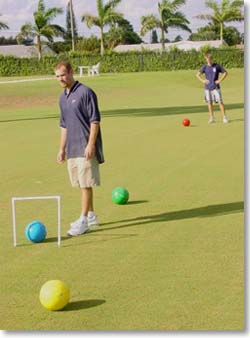
|
| SuperSize croquet started exclusively as a kicking game. These athletic directors from Palm Beach Atlantic University, circa 2002, are competing in a spirited game on the National Croquet Center's then-pristine Palm Courts--a county-mandated "dry retention area" organized for croquet and multi-sports, which was allowed to degrade in a period of financial crisis and is now being restored. |
Because it happened in many different locales throughout the huge show in the exhibit in the West Palm Beach convention hall, we stayed inside the Situation ourselves and enjoyed it throughout. The "audience" never found out what was going on. (In that respect, it was unique.)
The design of that Situation was perfectly logical. The woman in white was obviously super-rich, having three black-clad attendants. Even if her voice and manner were not already magisterial, the circumstances would crown her a queen. Extreme deference would be paid, everywhere, to the woman in the wheelchair (actually an impoverished novelist and poet), who plays her part with relish, directing her attendants in a stern, somewhat imperious way to certain works of art, at which she squints closely, to which she may gesture with her exquisitely ornate cane (borrowed from a wealthy friend for the occasion.)
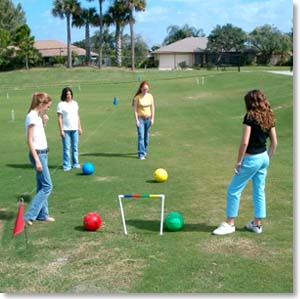
|
| Local schools were allowed to use the area free of charge and could play either the kicking game or the mallet version. |
This is played over and over, with endless variations. Only we four actors, finally, observe clearly the Situation, over and over again. We are all very careful, and yet the billionaire in white in the wheel chair pretends to be careless, with her gesturing cane, and we enjoy observing the mixed feelings of the gallery reps.
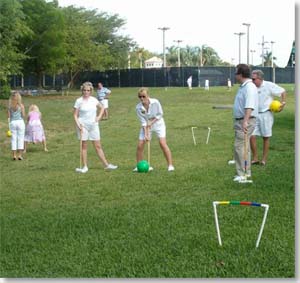
|
| For a period after he left Center management, Bob Alman marketed SuperSize events like this charity event on a huge course in Boca Raton, with ten games going on simultaneously. |
By examining that question seriously and minutely I had to make the decision not to stage what might have been our most spectacular Situation, for a cast of thousands. But when we played it out in our minds, seriously and thoroughly, we had to recognize that someone--and maybe many more than one--could be seriously injured and even killed.
I tried to talk myself out of feeling responsible for that, but ultimately, I couldn't. I had to confess to everyone that we would not do the Situation we had already planned and rehearsed and imagined in the greatest detail. I really think they might have gone on with it if I hadn't called a halt. But I think they all understood why I wasn't willing to go through with it.
Ultimately, the design and process of the Situation had argued convincingly against itself before it was ever staged. Serious consideration of the possible and even likely consequences killed the Situation before it it was ever enacted in physical space.
Bringing to life invisible public space
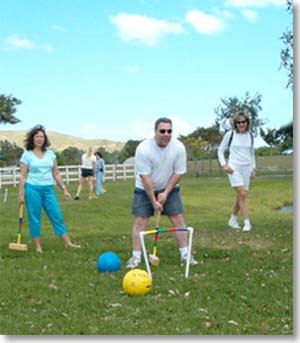
|
| The only problem with the singles groups who bought this event was that too few men showed up in proportion to the women. |
I could call the series FRONTIERS OF INVISIBLE SPACE, and the Cloverleaf Situation was to be the first of a series of Situations that would bring to visibility the "invisible" public spaces which are NEVER occupied or used for anything, except perhaps to separate visible and useful components--to truly be "empty" space. The best example is the MEDIAN of grass in the middle of a wide boulevard--and a small group of adventurers had done that as an experiment with me in Palm Beach.
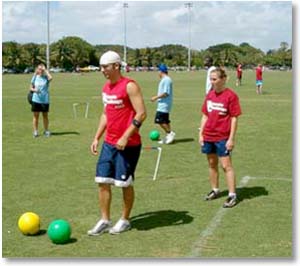
|
| The game was popular at a three-day Fringe Sports Festival at the University of Miami. |
Our mistake, we later realized, was wearing our whites. We looked like we belonged, and in Palm Beach, if you look like you belong, the police will we very loath to disturb you, whatever you do. They could get into trouble by doing that. (On the other hand, if you drive to Palm Beach in an old car with dented fenders, they could give you a ticket for anything.)
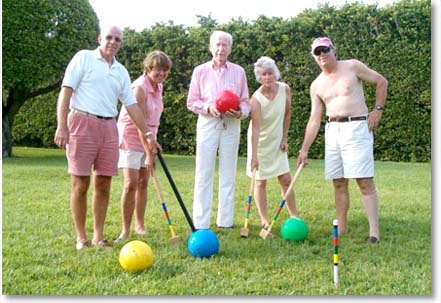
|
| When Bob Alman interviewed Herbert Bayard Swope at his home in Palm Beach somewhere around 2006 and showed his guests how to play, Swope, as referee, commented, "This game is very much in the spirit of what we did at Sands Point in the 20's." |
In the debrief, we realized it was the all-white clothes that had been our mistake. The police presence on the magic isle is tasked with the obligation to make things difficult for people who don't "belong" on the island; and on the other hand, to make those who DO belong feel good about everything they do. We realized that we had mislead the cop, who had to make the spot decision that all his fellows have learned to make in such a small-s situation. And they always choose the safest course, for their career. Looking too good, fitting in too well, had been our mistake.
We found the perfect clover-leaf, on I-95.
Nevertheless we had rehearsed a Situation that could be staged in a most more dramatic way, on a larger stage, to great effect. And we realized that for that Situation, we actually WOULD wear all-white, and it would be staged, ideally, in one of the huge spaces of a major cloverleaf of I-95. I found the ideal one, about 20 miles south of West Palm Beach, with many trees and some smaller bushes, none of which would obstruct a near-total view of the action from cars traveling around the cleverleaf.
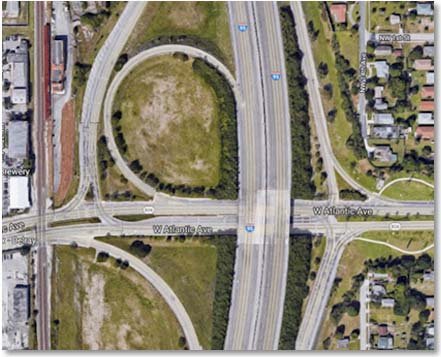
|
| We decided that the most spectacular "invisible public space" for our Situation would be this wide clover-leaf, perhaps 250 feet across, about twenty miles south of West Palm Beach. A preliminary investigation of the site determined exactly where we would park the cars and precisely how we would begin the games within five minutes of being noticed by anyone--more than enough time for Bob to install the first of eight oversized wickets. After the first game of Golf Croquet started, the next could immediately follow. Eight white-clad adventurers would be vigorously populating a previously uninhabited space. |
The next thing we did was find the place where we could park, and from which we could embark with ten wickets and eight soccer balls (so there could be eight people playing, in two different games). I would referee.
Then meeting as a group, the nine of us (they would play, I would referee and interact with any "officials" who might approach) speculated on what was likely to happen, and what we would do. We had a general rule that we would plan exactly what would happen until the Situation would begin (the moment of "discovery") at which point everyone was entitled and encouraged to act on their own and in keeping with the spirit of the Situation. (Yes, it was deliberately vague. But we wanted honest reactions and actions, even in the staged event.)
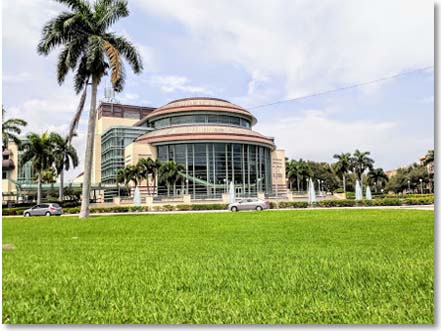
|
| The broad median between this concert hall on the north side of the boulevard and the West Palm Beach Convention Center behind the camera that snapped this picture was our first choice of locale--surely the busiest spot in the city, near downtown. The Situation was to be staged a little past 5:00 PM, to guarantee a lot of traffic going both ways. |
Someone said at some point in this imagining of the startled reaction of drivers observing this scene, "And there might be car accidents from the rubber-necking drivers....." That's what killed the idea aborning. After imagining what might happen, I was absolutely not willing to be responsible for someone dying. And now that the thought, had been spoken and discussed, I was culpable, already. I could never allow that to happen. Maybe nobody would be killed, maybe there wouldn't even be accidents--but I was absolutely unwilling to take that chance.
A small irony, in the scale of things
The crazy thing is that a bad accident would really be, in a sense, an ideal fulfillment of this Situation, and would probably be great publicity for the sport of croquet. (Trump had gotten lots of publicity for his International Golf Croquet a block away from the National Croquet Center some years ago when a golfer clubbed to death an intrusive swan.)
Because this was clearly the biggest, the most elaborate, the most potentially consequential of all the Situations I would ever design and produce, not actually staging it meant, to me, the end of designing and producing Situations.
If you, dear reader, decide to produce something like this on your own, I warn you: Could you bear the guilt of the kind of lethal outcome we have vividly imagined and thus not dared to risk? I beg you, sincerely, not to try, because even publishing this article on a small niche website might be enough to get someone killed. I dare not pursue any further this mental exercise in ethics.
Bob Alman co-developed at the National Croquet Center early in the century the SuperSized Croquet concept and equipment, which is still available for purchase from Don Oakley on his online Croquet Store. We found out more than we wanted to know about Internet marketing as a consequence. The equipment we put together is first-rate: long-lasting, sturdy, sufficient for use over many years. However, on the Internet, "similar" equipment can be advertised to look just as good and can sell much more cheaply. So a further irony is that the very good idea--of having a croquet-like game that could be played on many terrains and long grass--self-destructed as a broad-based phenomenon simply by being available in the indiscriminate marketplace we call the World Wide Web.